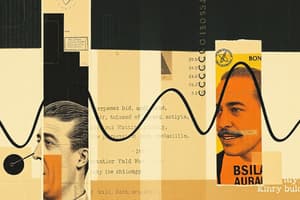Podcast
Questions and Answers
Which of the following statements best describes the two steps of enzymatic reactions in Michaelis-Menten kinetics?
Which of the following statements best describes the two steps of enzymatic reactions in Michaelis-Menten kinetics?
- Binding of the substrate is reversible, while the catalysis step is irreversible. (correct)
- Catalysis is reversible, while binding of the substrate is irreversible.
- Both steps are reversible.
- Both steps are irreversible.
The Michaelis constant (Km) is directly related to the binding affinity of the substrate to the enzyme.
The Michaelis constant (Km) is directly related to the binding affinity of the substrate to the enzyme.
False (B)
What is the equation for the velocity of catalysis in Michaelis-Menten kinetics?
What is the equation for the velocity of catalysis in Michaelis-Menten kinetics?
v = (Vmax * [S]) / (Km + [S])
In Michaelis-Menten kinetics, the first step involves the formation of an enzyme-substrate ________.
In Michaelis-Menten kinetics, the first step involves the formation of an enzyme-substrate ________.
What aspect of enzymatic reactions does the Michaelis-Menten model primarily simplify?
What aspect of enzymatic reactions does the Michaelis-Menten model primarily simplify?
The Michaelis-Menten model is the only model used to understand enzyme kinetics.
The Michaelis-Menten model is the only model used to understand enzyme kinetics.
Why is the Michaelis-Menten kinetics model considered a good starting point for studying enzyme kinetics?
Why is the Michaelis-Menten kinetics model considered a good starting point for studying enzyme kinetics?
Match the terms with their correct definitions:
Match the terms with their correct definitions:
What does a larger value for the Michaelis constant (Km) indicate about the enzyme's affinity for its substrate?
What does a larger value for the Michaelis constant (Km) indicate about the enzyme's affinity for its substrate?
A smaller Km value implies lower affinity of the enzyme for the substrate.
A smaller Km value implies lower affinity of the enzyme for the substrate.
What is Vmax in the context of enzyme kinetics?
What is Vmax in the context of enzyme kinetics?
At low substrate concentrations, the graph of velocity versus substrate concentration shows a __________ relationship.
At low substrate concentrations, the graph of velocity versus substrate concentration shows a __________ relationship.
Match the following enzyme terms with their descriptions:
Match the following enzyme terms with their descriptions:
What happens to the denominator in the Michaelis-Menten equation when substrate concentration is significantly higher than Km?
What happens to the denominator in the Michaelis-Menten equation when substrate concentration is significantly higher than Km?
As substrate concentration increases, the velocity of the reaction continues to increase linearly without limit.
As substrate concentration increases, the velocity of the reaction continues to increase linearly without limit.
The velocity of an enzyme-catalyzed reaction approaches Vmax as substrate concentration becomes much __________ than Km.
The velocity of an enzyme-catalyzed reaction approaches Vmax as substrate concentration becomes much __________ than Km.
At what substrate concentration does the velocity equal half the maximum velocity (Vmax)?
At what substrate concentration does the velocity equal half the maximum velocity (Vmax)?
Km has units of concentration.
Km has units of concentration.
What effect does adding Km and Fs have on their units?
What effect does adding Km and Fs have on their units?
When the substrate concentration equals the _____ value, the velocity reaches half the maximum velocity.
When the substrate concentration equals the _____ value, the velocity reaches half the maximum velocity.
What is the name commonly used for the double reciprocal plot?
What is the name commonly used for the double reciprocal plot?
The Km value can be approximated from a velocity versus substrate graph.
The Km value can be approximated from a velocity versus substrate graph.
What happens to Km + Km in the context of velocity calculations?
What happens to Km + Km in the context of velocity calculations?
Match the following terms with their definitions:
Match the following terms with their definitions:
What does the y-intercept of a double reciprocal plot represent?
What does the y-intercept of a double reciprocal plot represent?
The x-intercept of a double reciprocal plot can be a negative value of substrate concentration.
The x-intercept of a double reciprocal plot can be a negative value of substrate concentration.
What does the slope of a double reciprocal plot represent?
What does the slope of a double reciprocal plot represent?
In competitive inhibition, the inhibitor competes with the __________ for the active site.
In competitive inhibition, the inhibitor competes with the __________ for the active site.
Match the following terms with their meanings:
Match the following terms with their meanings:
Which expression represents the relationship of the slope in a double reciprocal plot?
Which expression represents the relationship of the slope in a double reciprocal plot?
A double reciprocal plot is useful for determining both Vmax and Km values.
A double reciprocal plot is useful for determining both Vmax and Km values.
The y-intercept in a double reciprocal plot provides the value of __________.
The y-intercept in a double reciprocal plot provides the value of __________.
What is a hallmark of a competitive inhibitor?
What is a hallmark of a competitive inhibitor?
Km increases when a competitive inhibitor is present.
Km increases when a competitive inhibitor is present.
What is affected in a double reciprocal plot when comparing different inhibitor concentrations?
What is affected in a double reciprocal plot when comparing different inhibitor concentrations?
Non-competitive inhibitors bind at locations other than the ______.
Non-competitive inhibitors bind at locations other than the ______.
Which of the following statements accurately describes the behavior of Vmax with a competitive inhibitor?
Which of the following statements accurately describes the behavior of Vmax with a competitive inhibitor?
Match the following types of inhibitors with their characteristics:
Match the following types of inhibitors with their characteristics:
The slope of a double reciprocal plot remains the same in the presence of a competitive inhibitor.
The slope of a double reciprocal plot remains the same in the presence of a competitive inhibitor.
What does a constant y-intercept in a double reciprocal plot imply?
What does a constant y-intercept in a double reciprocal plot imply?
What happens to the affinity of an enzyme for its substrate when the Michaelis constant (Km) increases?
What happens to the affinity of an enzyme for its substrate when the Michaelis constant (Km) increases?
As substrate concentration increases, the reaction velocity initially increases linearly before plateauing.
As substrate concentration increases, the reaction velocity initially increases linearly before plateauing.
What is the relationship between substrate concentration and reaction velocity at low substrate levels?
What is the relationship between substrate concentration and reaction velocity at low substrate levels?
As substrate concentration becomes much larger than the Km value, V approaches __________.
As substrate concentration becomes much larger than the Km value, V approaches __________.
Match the following scenarios to their effects on enzyme kinetics:
Match the following scenarios to their effects on enzyme kinetics:
Which statement best describes the behavior of velocity as more substrate is added beyond a certain point?
Which statement best describes the behavior of velocity as more substrate is added beyond a certain point?
The Michaelis-Menten equation only applies to reversible enzyme-catalyzed reactions.
The Michaelis-Menten equation only applies to reversible enzyme-catalyzed reactions.
When the substrate concentration equals Km, what is the reaction velocity relative to Vmax?
When the substrate concentration equals Km, what is the reaction velocity relative to Vmax?
What does the y-intercept of a double reciprocal plot represent?
What does the y-intercept of a double reciprocal plot represent?
The x-intercept of a double reciprocal plot represents a positive value of substrate concentration.
The x-intercept of a double reciprocal plot represents a positive value of substrate concentration.
What is the relationship between the slope of a double reciprocal plot and Km and Vmax?
What is the relationship between the slope of a double reciprocal plot and Km and Vmax?
In competitive inhibition, the inhibitor competes with the __________ for the active site.
In competitive inhibition, the inhibitor competes with the __________ for the active site.
Match the following components of a double reciprocal plot with their meanings:
Match the following components of a double reciprocal plot with their meanings:
When performing a double reciprocal plot, what does a larger value of Km indicate?
When performing a double reciprocal plot, what does a larger value of Km indicate?
In the double reciprocal plot, both Km and Vmax can be directly determined from the graph without additional calculations.
In the double reciprocal plot, both Km and Vmax can be directly determined from the graph without additional calculations.
What is the significance of the double reciprocal plot in enzyme kinetics?
What is the significance of the double reciprocal plot in enzyme kinetics?
What is the hallmark of competitive inhibition in enzyme kinetics?
What is the hallmark of competitive inhibition in enzyme kinetics?
In competitive inhibition, the same y-intercept appears on a double reciprocal plot for different inhibitor concentrations.
In competitive inhibition, the same y-intercept appears on a double reciprocal plot for different inhibitor concentrations.
What type of inhibitor does not bind at the active site?
What type of inhibitor does not bind at the active site?
In a double reciprocal plot, the slope is equal to __________ divided by Vmax.
In a double reciprocal plot, the slope is equal to __________ divided by Vmax.
Match the following characteristics with their respective inhibitor types:
Match the following characteristics with their respective inhibitor types:
How does a competitive inhibitor affect the Km value?
How does a competitive inhibitor affect the Km value?
The x-intercept in a double reciprocal plot is associated with the Vmax value.
The x-intercept in a double reciprocal plot is associated with the Vmax value.
When comparing enzyme activity with varying concentrations of a competitive inhibitor, what observable change occurs in the Km value?
When comparing enzyme activity with varying concentrations of a competitive inhibitor, what observable change occurs in the Km value?
What effect does a competitive inhibitor have on Km?
What effect does a competitive inhibitor have on Km?
A competitive inhibitor does not bind to the active site of an enzyme.
A competitive inhibitor does not bind to the active site of an enzyme.
What must happen for the effect of a competitive inhibitor to be overcome?
What must happen for the effect of a competitive inhibitor to be overcome?
With a competitive inhibitor, the maximum velocity (Vmax) of the reaction __________.
With a competitive inhibitor, the maximum velocity (Vmax) of the reaction __________.
Match the following terms with their effects on enzyme kinetics:
Match the following terms with their effects on enzyme kinetics:
How does the presence of a competitive inhibitor affect the affinity of the enzyme for the substrate?
How does the presence of a competitive inhibitor affect the affinity of the enzyme for the substrate?
A higher concentration of substrate can completely eliminate the effect of a competitive inhibitor.
A higher concentration of substrate can completely eliminate the effect of a competitive inhibitor.
What happens to the velocity of the reaction as substrate concentration approaches Vmax?
What happens to the velocity of the reaction as substrate concentration approaches Vmax?
What is the effect of a non-competitive inhibitor on the Vmax of an enzymatic reaction?
What is the effect of a non-competitive inhibitor on the Vmax of an enzymatic reaction?
The Michaelis constant (Km) changes when a non-competitive inhibitor is present.
The Michaelis constant (Km) changes when a non-competitive inhibitor is present.
Explain how a non-competitive inhibitor affects catalytic activity.
Explain how a non-competitive inhibitor affects catalytic activity.
In the presence of a non-competitive inhibitor, the Vmax is _____ while the Km is _____ .
In the presence of a non-competitive inhibitor, the Vmax is _____ while the Km is _____ .
Match the following terms with their corresponding effects:
Match the following terms with their corresponding effects:
Which statement characterizes the effect of non-competitive inhibition?
Which statement characterizes the effect of non-competitive inhibition?
The x-intercept in a double reciprocal plot is used to determine the value of Km.
The x-intercept in a double reciprocal plot is used to determine the value of Km.
What happens to the slope of the double reciprocal plot when a non-competitive inhibitor is present?
What happens to the slope of the double reciprocal plot when a non-competitive inhibitor is present?
Flashcards are hidden until you start studying
Study Notes
Enzyme Kinetics and Michaelis-Menten Model
- Substrate enzymes are not initially a perfect fit; they can be modified to facilitate binding, improving the enzyme-substrate complex efficiency.
- Michaelis-Menten kinetics is a fundamental model for studying enzyme reactions, distinguished by its two-step mechanism: binding of substrates and conversion to products.
- The first step (binding) is reversible, while the second step (catalysis) is generally considered irreversible for many enzymes.
Michaelis-Menten Equation
- The velocity of an enzymatic reaction is expressed as:
- Velocity = Vmax * [S] / (Km + [S]), where [S] is substrate concentration.
- The Michaelis constant (Km) indicates the affinity of the enzyme for its substrate:
- A high Km value corresponds to low affinity, while a low Km value indicates high affinity.
Velocity-Substrate Concentration Curve
- At low substrate concentrations, the velocity increases linearly with substrate concentration due to the enzyme's availability and proportional relationship.
- As substrate concentration increases, the curve begins to plateau, approaching Vmax, indicating that the enzyme sites are saturated and Km becomes less significant.
- Km serves as the substrate concentration at which the reaction velocity reaches half of Vmax.
Double Reciprocal (Lineweaver-Burk) Plot
- This plot uses the inverse of the velocity (1/V) vs. the inverse of substrate concentration (1/[S]), producing a linear representation.
- Y-intercept corresponds to 1/Vmax, and X-intercept is -1/Km; the slope is Km/Vmax, providing a method to extract kinetic parameters from the graph.
Types of Enzyme Inhibition
-
Competitive Inhibition:
- Occurs when an inhibitor competes with the substrate for the active site on the enzyme.
- Vmax remains constant, while Km increases, indicating that more substrate is needed to reach half Vmax.
- A double reciprocal plot for competitive inhibition will show the same y-intercept but varying x-intercepts as Km changes.
-
Non-competitive Inhibition:
- Inhibitor binds to an enzyme at a site other than the active site, affecting the catalytic action, regardless of substrate presence.
- This does not alter Km, but it reduces Vmax, as enzyme activity can be inhibited regardless of substrate concentrations.
Summary
- Understanding the relationship between substrate concentration, Km, Vmax, and how various inhibitors affect enzyme kinetics is crucial for biochemical studies.
- Being able to interpret velocity vs. substrate concentration curves, as well as double reciprocal plots, is key for determining enzyme behavior in different conditions.
Enzyme Kinetics and Michaelis-Menten Theory
- The Michaelis constant (Km) indicates the affinity of an enzyme for its substrate; a higher Km signifies lower affinity, whereas a lower Km indicates higher affinity.
- Velocity (V) initially increases linearly with substrate concentration at low levels, as Km is often greater than the substrate concentration.
- At high substrate concentrations, the velocity approaches Vmax as the impact of Km becomes negligible in the denominator of the Michaelis-Menten equation.
- Vmax represents the maximum rate of reaction and can be approximated where the curve asymptotically approaches this value on a velocity vs. substrate concentration graph.
Double Reciprocal Plot
- The double reciprocal plot (1/V vs. 1/[S]) yields a straight line.
- The y-intercept of this plot is related to Vmax (y-intercept = 1/Vmax) and the x-intercept is linked to Km (x-intercept = -1/Km).
- The slope of this graph is equal to Km/Vmax; thus, it can be used to determine both constants through analysis.
Competitive Inhibition
- Competitive inhibitors bind to the active site of the enzyme, competing with the substrate.
- Higher concentrations of substrate can outcompete the inhibitor, ultimately restoring Vmax but increasing Km.
- Km increases due to a decrease in affinity towards the substrate as the enzyme is more often occupied by the inhibitor, while Vmax remains unchanged.
- The velocity vs. substrate concentration curve shows Km shifting rightward for competitive inhibition, indicating a greater required substrate concentration to reach half Vmax.
Double Reciprocal Plot for Competitive Inhibition
- In a double reciprocal plot, competitive inhibition results in the same y-intercept (indicating no change in Vmax) but different x-intercepts (indicating a change in Km).
- The slope of the line increases for competitive inhibition as Km increases.
Non-Competitive Inhibition
- Non-competitive inhibitors bind to a site other than the active site, impacting either the free enzyme or enzyme-substrate complex.
- Vmax decreases due to a reduction in catalytic efficiency, but Km remains unchanged since there is no competition for the active site.
- The velocity vs. substrate concentration curve for non-competitive inhibition reaches a lower maximum velocity compared to the uninhibited reaction.
Double Reciprocal Plot for Non-Competitive Inhibition
- In the double reciprocal plot for non-competitive inhibition, the x-intercept (related to Km) remains the same, indicating that Km is unchanged.
- The y-intercept changes due to the reduced Vmax, reflecting the decreased maximum rate of reaction.
Summary of Key Differences
- Competitive inhibition affects Km but not Vmax; the inhibitor competes at the active site.
- Non-competitive inhibition affects Vmax but not Km; binding occurs at a different site, altering the enzyme's ability but not its affinity for the substrate.
Studying That Suits You
Use AI to generate personalized quizzes and flashcards to suit your learning preferences.



